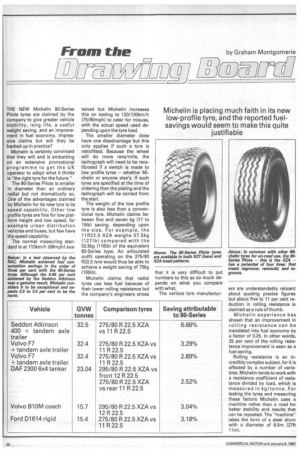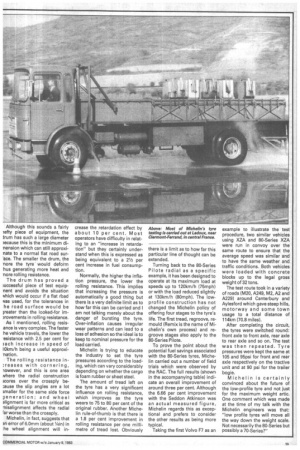From the )Er j b]iw zi ?( 0 - 1 G
Page 40

Page 41

If you've noticed an error in this article please click here to report it so we can fix it.
by Graham Montgomerie
THE NEW Michelin 80-Series Pilote tyres are claimed by the company to give greater vehicle stability, long life, a useful weight saving, and an improvement in fuel economy. Impressive claims but will they be backed up in practice?
Michelin is certainly convinced that they will and is embarking on an extensive promotional programme to get the UK operator to adopt what it thinks is "the right tyre for the future."
The 80-Series Pilote is smaller in diameter than an ordinary radial but not dramatically so. One of the advantages claimed by Michelin for its new tyre is its speed capability. Other low profile tyres are fine for low platform height and low speed, for example urban distribution vehicles and buses, but few have the speed capability.
The normal measuring standard is at 110km/h (68mph) sus tamed but Michelin increases this on testing to 120/130km/h (75/80mph) to cater for misuse, with the actual speed used depending upon the tyre load.
The smaller diameter does have one disadvantage but this only applies if such a tyre is retrofitted. Because the wheel will do more revs/mile, the tachograph will need to be recalibrated if a switch is made to low profile tyres — whether Michelin or anyone else's. If such tyres are specified at the time of ordering then the plating and the tachograph will be correct from the start.
The weight of the low profile tyre is also less than a conventional tyre. Michelin claims between five and seven kg (11 to 151b) saving, depending upon the size. For example, the 11R22.5 XZA weighs 57.5kg (1 271b) compared with the 52.5kg (1161b) of the equivalent 80-Series type. An articulated outfit operating on the 275/80 R22.5 tyre would thus be able to achieve a weight saving of 75kg (1651b).
Michelin claims that radial tyres use less fuel because of their lower rolling resistance but the company's engineers stress that it is very difficult to put numbers to this as so much depends on what you compare with what.
The various tyre manufactur ems are understandably reticent about quoting precise figures but about five to 11 per cent reduction in rolling resistance is claimed as a rule of thumb.
Michelin experience has shown that an improvement in rolling resistance can be translated into fuel economy by a factor of 0.25. In other words, 25 per cent of the rolling resistance improvement is seen as a fuel saving.
Rolling resistance is an incredibly complex subject, for it is affected by a number of variables. Michelin tends to work with a resistance coefficient of resistance divided by load, which is measured in kg/tonne. For testing the tyres and measuring these factors Michelin uses a machine rather than a road for better stability and results that can be repeated. The "machine" takes the form of a steel drum with a diameter of 8.5m (27ft 11in).
Although this sounds a fairly lefty piece of equipment, the irum has such a large diameter )ecause this is the minimum dinension which can still approxinate to a normal flat road surace. The smaller the drum, the nore the tyre would deform hus generating more heat and nore rolling resistance.
The drum has proved a ;uccessful piece of test equipnent and avoids the situation vhich would occur if a flat rbad vas used, for the tolerances in he road surface would be Ireater than the looked-for im)rovements in rolling resistance.
As I mentioned, rolling resisance is very complex. The faster he vehicle travels, the lower the esistance with 2.5 per cent for ;ach increase in speed of 10km/h being a useful approxination,
The rolling resistance in:reases with cornering, lowever, and this is one area where the radial construction ;cores over the crossply be-.:ause the slip angles are a lot amaller for the same side force jeneration; and wheel alignment is far more critical as inisalignment affects the radial 'ar worse than the crossply.
Michelin, in fact, suggests that an error of 6.0mm (about 1/4in) in he wheel alignment will in crease the retardation effect by about 10 per cent. Most operators have difficulty in relating to an "increase in retardation" but they certainly understand when this is expressed as being equivalent to a 21/2 per cent increase in fuel consumption.
Normally, the higher the inflation pressure, the lower the rolling resistance. This implies that increasing the pressure is automatically a good thing but there is a very definite limit as to how far this can be carried and I am not talking merely about the danger of bursting the tyre. Over-inflation causes irregular wear patterns and can lead to a loss of adhesion so the ideal is to keep to nominal pressure for the load carried.
Michelin is trying to educate the industry to set the tyre pressures according to the loading, which can vary considerably depending on whether the cargo is foam rubber or sheet steel.
The amount of tread left on the tyre has a very significant influence on rolling resistance, which improves as the tyre wears to 75 to 80 per cent of the original rubber. Another Michelin rule-of-thumb is that there is a 1.8 per cent improvement in rolling resistance per one millimetre of tread lost. Obviously there is a limit as to how far this particular line of thought can be extended.
Turning back to the 80-Series Pilote radial as a specific example, it has been designed to operate at its maximum load at speeds up to 120km/h (75mph) or with the load reduced slightly at 130km/h (80mph). The lowprofile construction has not changed the Michelin policy of offering four stages to the tyre's life. The first tread, regroove, remould (Remix is the name of Michelin's own process) and regroove stages also apply to the 80-Series Pilote.
To prove the point about the potential fuel savings associated with the 80-Series tyres, Michelin carried out a number of field trials which were observed by the RAC. The full results (shown in the accompanying table) indicate an overall improvement of around three per cent. Although the 6.66 per cent improvement with the Seddon Atkinson was an actual measured figure, Michelin regards this as exceptional and prefers to consider the other results as being more typical.
Taking the first Volvo F7 as an example to illustrate the test procedure, two similar vehicles using XZA and 80-Series XZA were run in convoy over the same route to ensure that the average speed was similar and to have the same weather and traffic conditions. Both vehicles were loaded with concrete blocks up to the legal gross weight of 32 tons.
The test route took in a variety of roads (M20, A249, M2, A2 and A229) around Canterbury and Aylesford which gave steep hills, motorway and some town usage to a total distance of 114km (70.8 miles).
After completing the circuit, the tyres were switched round: front axle to front axle, rear axle to rear axle and so on. The test was then repeated. Tyre pressures were kept the same at 105 and 95psi for front and rear axle respectively on the tractive unit and at 90 psi for the trailer bogie.
Michelin is certainly convinced about the future of the low-profile tyre and not just for the maximum weight artic. One comment which was made at the time of my talk with the Michelin engineers was that: "low profile tyres will move all the way down the weight scale. Not necessarily the 80-Series but possibly a 70-Series?"








































































